In the section of loop-like stitches resemble a loop. To the loop-like stitches include: bridging, marking, blind stitch hidden, uspeshnye copy.
Bridging loop-shaped stitches are used for permanent connection of the two parts in those cases when a native implementation of the lines difficult.
By the way: here it is, the stitch, who used a seamstress before the invention of the sewing machine! 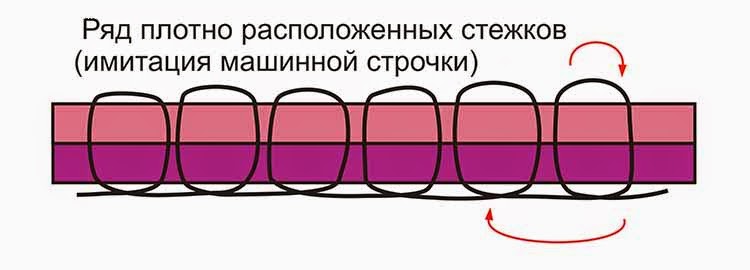
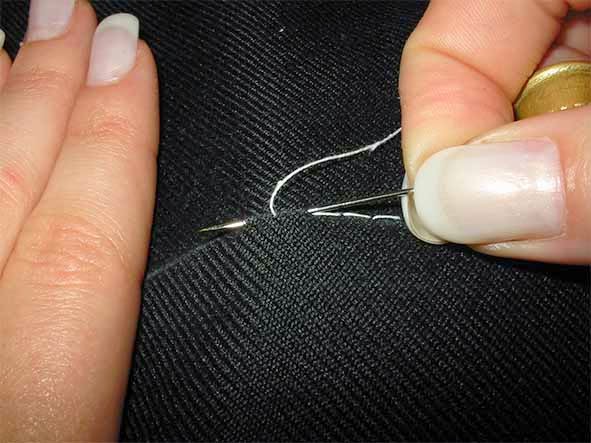
The two parts are folded, right sides inside, edging edge call and the intended line insert the needle downward and bring to the front the same as when you run a running stitch straight stitches. But then the needle is again introduced into the first point of a puncture and brought to the surface, while the step length on the lower side should be two times more than with the upper hand. As a result of multiple repetition of the chain is formed closely adjacent to each other in stitches. Frequency 3-5 stitches 1 cm
Marking loop-shaped stitches are used for permanent bonding of the lining of the product or the shoulder pads with the armhole (seam vrachevanie sleeves) in the men's and women's clothing, which is manufactured according to individual orders. On the structure of the scribing lines reminiscent of bridging, but unlike the latter, when the marking lines of the needle into the fabric in the middle between the two previous punctures. Stitch length 1.5-2 cm
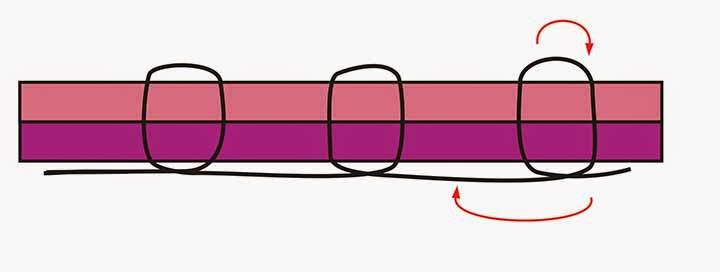
In appearance marking line on the front side similar to a running line of straight stitches, but due to the fact that the marking stitches are loop-like structure, to achieve a strong flexible connection.
Loop-like stitches blind stitch is used for the permanent fastening of the bent edges of the parts with a closed cut (in the manufacture of outer clothing for individual orders), for example, to podseleniya the bottom of the product, to connect the parts of the base material, for example patch pockets with the product, etc. blind stitch the stitch loop-like stitches perform as well as blind stitch stitch slanting stitches. The needle is first introduced into the fold the bent edge of the top part, and then at the level of the puncture of this part is pierced with the lower part half the thickness (in contrast to blind stitch the stitching of oblique stitches, which grip the bottom part to do with a slight shift to the side). Frequency 3-5 stitches 1 cm 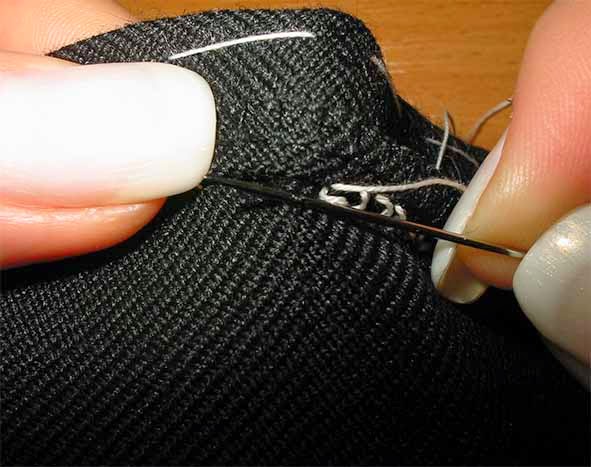
The photo shows not quite correct reception of stitch: a seam allowance of the part is bent on the wrong side, zamatyvaetsya and prietaisams, then part of the seam allowance of 0.7-0.8 cm and is executed loop-shaped blind stitch stitches in the open area. Correct to perform so, as shown in the photo below: 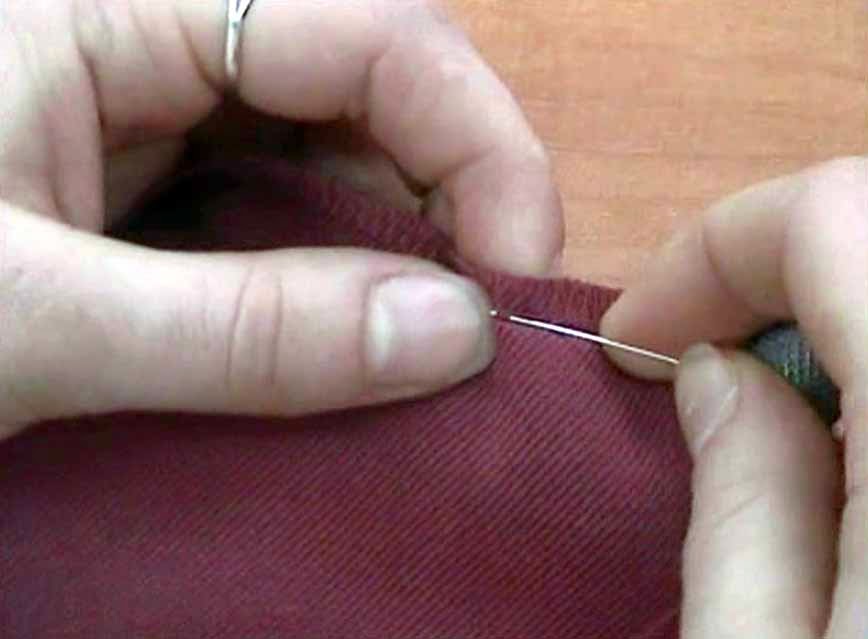
Bent allowance for processing bottom COMPLETELY bent backwards, with the exception of the area from the edges denoting the width of the bead(in the photo is serged the cut), and the suturing is done along the edge, almost on the fold of detail that provides benefits in case of incomplete perforation of the material.
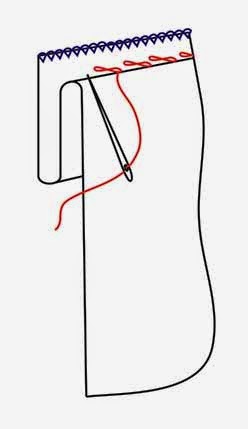
The correct position of the parts and of the needle when suturing bottom: allowance bent back, the suturing is done along the fold.
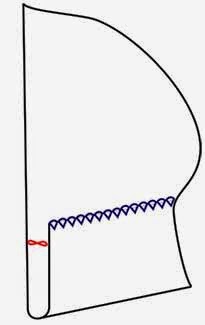
The final look after podseleniya: blind stitch line (indicated in red) is not visible either from the front side parts or front side of seam allowance. The stitches are doing fine cotton thread No. 50 or silk 60 No. 33, 65 in color. Because both layers of fabric are pierced not all, lines do not vdno on the front side, that is, it is hidden. Tight stitches are not delayed.
Uspeshnye loop-like stitches used to finish edges of collars, lapels, collar, hem etc. According to their structure uspeshnye lines are a kind of bridging lines and differ from their shorter length (0.5-1 mm) so that the thread stitches are placed inside the fastening of fabrics and stitching not visible from the top and bottom sides of the fabric. The frequency of the stitches depends on the thickness of the fabric and varies from 2 to 5 1 cm
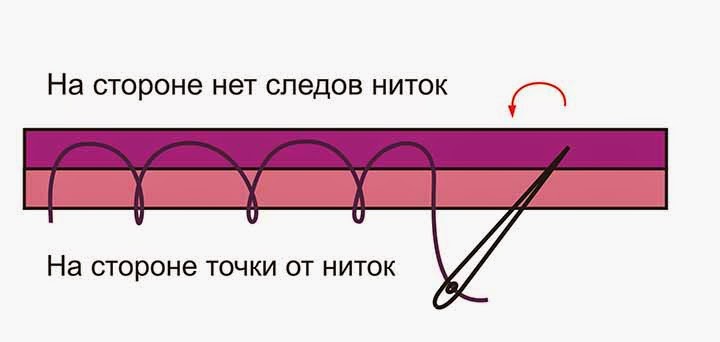
Uspeshnye ways of doing a fine needle, silk thread No. 33, 65, 75 in color. Needle injected into the tissue with a slight tilt forward, pierce through the top cloth, the bottom — half its thickness and remove the needle up, then re-injected into the tissue at a distance of 0.5-1 mm from the point o of the needle to the surface or in the hole, giving a small inclination of the needle to advance and stitch formation in cloth, etc. To line was not visible, the stitches should not be delayed.
Copy loop-shaped stitches are used for accurate transfer of lines from one part to another symmetrical. The details add up, right sides inside, according to the planned lines are laid stitches with a length of 0.3-0.5 cm at a distance of 0.3-1 cm from each other C/b thread. The thread is not tightened so that it forms a loop 1-1. 5 cm depending on the thickness of the material.

Scissors is a uniform splitting of the layers throughout the length of the copy lines up to the full tension of the thread of the stitches on the inside layers of the workpiece. The stitches are cut exactly in the middle parts. The second part traces the copy of stitches held the chalk line.



